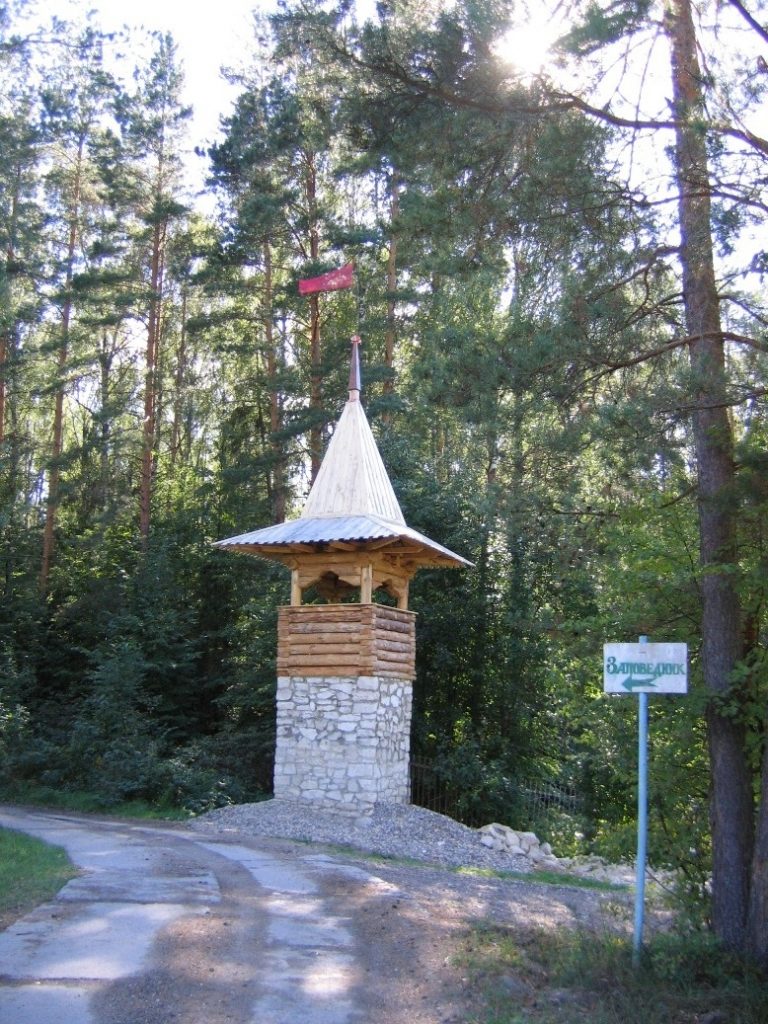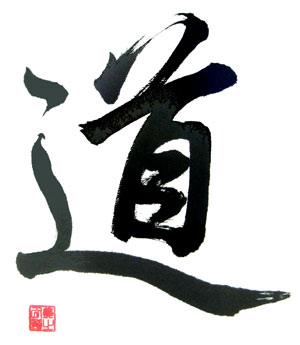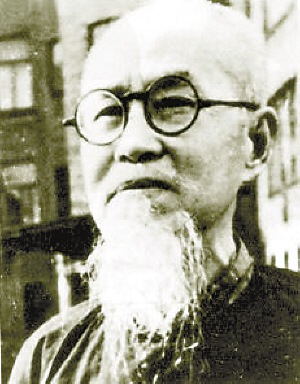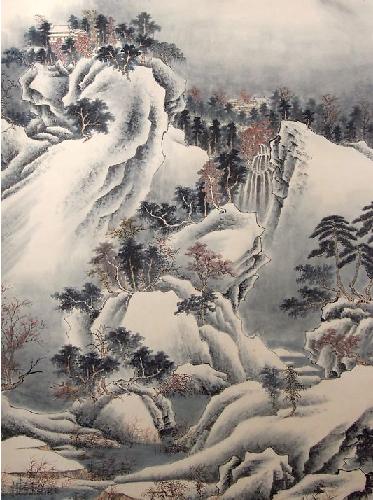Strolling in Chinese Garden: An Experience of Self-Re(dis)covering
Vladimir Maliavin

Not accidentally Asia has been called since ancient times the First Continent, the Mother of Humankind. Asian landscapes in their bewildering variety – both natural and artistic – represent in essence the original space/place of existence, the primordial Void filled by the plenitude of life’s images. In stark contrast to the European thinking based on the opposition of subject and object, ideal and material, spirit and body, reason and emotions and all kinds of confrontations and antagonisms stemming from it, Asian cultural space is structured by the void at its core and the gradual accumulation of complexity in the direction of the periphery. It is true both geographically if we bear in mind that Asia’s heartland is the vast desert of the Silk Road (dividing and linking at the same time) and phenomenologically because in Asia the void is considered to be the center of human experience. It is, above all, the void of the “childish heart”, pure and simple. Asians are playful like children.
Asian space as a place of play, a self-play, is essentially a differentiating continuity. The latter’s each point or rather the unobservable distancing from oneself provides access to the holy (W)holeness through sacred spots before or beyond specific religious creeds. Thus the internal sanctity of life is tacitly asserted and spiritual power dissolves into the immanent qualities of life, filling it with intensive, vibrant, dynamic qualities.
Chinese tradition has developed a profound understanding of non-duality of transcendence and immanence, subjective and objective, spiritual and physical dimensions of life. The appreciation of the landscape in China has never been a matter of disinterested contemplation, let alone scientific exploration, but rather of bringing together the inner and the outer dimensions of the world. It aims at confirming the “harmonious unity of Man and Heaven” (tian ren he yi); the unity as reflective, as it is spontaneous, rational and emotional. The landscapes in Chinese pictorial art were supposed to appear “out of dreams” with the help of (fictitious) memory and creative imagination. Their real impulse was “ancient feeling” (gu qing) or “ancient Will” (gu yi), the core of existence which is forever absent in thoughts or perceptions.
The best image then is non-image and the best traveler is the one who never moves. Yet the silence is reached at the limit of all sounds. This is why the backyard garden, informal and even intimate, has become in China the best space for skilful traveling – the one that serves as a means for intensifying the living experience and articulating the spatial/temporal dimensions of life. It is the testimony to the human presence in the world which, like Beauty and the sense of life itself, is fully manifested but hidden from all views just because they are partial. The all-embracing vision is equal to blindness. As the early treatise on self-cultivation, Xi sui jing states, “the one who practices the Dao, is like a blind man walking without a cane”. The world of the blind man is unitary without form and impeccably whole in its each and every point. This is the World of Dao – the absolute pattern of things or rather the absolute Event of Being in which not a single moment of existence is lost. The great Way springs forth at every turn of the road.
These observations help to explain why the design of Chinese garden requires all elements of Nature: earth, water, stones, vegetation, sky as well as man (in the form of all signs of human presence such as buildings, bridges, paths, walls, pavilions etc.). But above all, the space of Chinese garden is based on the idea of subtle correspondences and continuity between these elements. The Dao is the way to oneself realized anytime and anywhere. It transforms traveling into an exercise in recovering one’s Self as essentially discovering one’s infinity in the finiteness of existence. This is the real meaning of things co-responding to each other. The Being is confirmed by the non-being of things in their interpenetration where everything is to the extent it is not. Perhaps the best expression of this truth is provided by Apostle Paul’s famous dictum on the passing of “the time of this world” which makes the wise “to possess as if not possessing, to rejoice as if not rejoicing”. This means also that to be genuine is to be similar to being genuine.
Finally we must assert that man’s Being returns to him in letting-go everything. This discovery points to the zone of our true safety because in letting go the world we stand before all things or rather anticipate their coming, pre-determine them. Paradise is the garden because garden’s space – both in the West and in China in their own ways – affirms everything in its absent fullness. It possesses salvational power.
My main thesis is as simple as it is difficult to prove. It is simple because the space of Chinese garden was in fact a testimony to the primordial experience of spiritually significant human living which was gradually clarified in the course of Chinese history. Its organizational principles appeal to the deepest and the most universal psychological truths of man. This accounts for the fact that Chinese painting or landscape architecture can please even the most ignorant observer. Yet it is extremely hard to substantiate this thesis since we are dealing with an experience of a lived body, a sort of corporeal intentionality whose nature is precisely to disappear in any perceived data or thinking. It is, as Merleau-Ponty remarked, a “cachette de la vie”, vibrant with power and all-pervading to be sure, but totally elusive. In modern Chinese literature it is often called simply “corporeal awareness” (ti wu ).
Today we already possess reliable and systematic knowledge of this reality (Nagatomo, 1992; Wu, 1998; Maliavin, 2011). Yet this knowledge can be expressed only symbolically in a notoriously vague terms. It reveals itself in allusions and metaphors. It is always outside or rather antecedent to what is represented. Such is the language of strolling in the garden: an easy chatting when the words are being said “by the way” spontaneously yet according to the universal rhythm of life and hence always appropriately.
As the above quoted instruction from Xi sui jing reminds, a pure awareness of the lived body is precisely being plunged into some nimble wholeness, essentially dynamic, equally intimate and alien yet arousing the capacity for concentration. Speaking in spatial terms, we are dealing with the continuity of the point and the sphere. This reality has neither measure nor anything outside of it, it cannot be expressed or fixed, it leaves behind only its dead traces. Such is the language of the awakened Heart: metaphorical, since it points to the inner dynamism of life, and metonymical because it operates only with pure actualities. In the final account this language invokes the image of a spinning sphere permanently returning to the absent origin, an infinitely complex whirlpool. It is running still and yet into the ever more subtle nuances of experience. It is running like blowing up.
Hence the basic Chinese principle: in order to get access to reality or, simply speaking, to live through the world one needs to move like clouds that penetrate with noble calmness the cliffs. Appreciation of travelling in China stemmed, I think, from this equation of Self with corporeal awareness, that kinesthetic unity of the body which gave birth to the traditional Chinese concept of reality as “spontaneous fusion of One Body”. If the enlightened mind “has no dwelling place in itself” (Chuang-zi) then it can do only one thing: to hit the road or, rather, to hit the Way. But this is the way to one’s true Self. Significantly, the concept of roaming (you) in ancient China referred both to the Taoist spiritual ideal and to the mastery in arts (in fact mastery over one’s body in artistic creativity). Travelling is indeed an exercise in mastering oneself.
We know that Confucius has reached full maturity during his 14 years of travelling. Lao-zi gave his final instruction to the world by going to the West. Taoist and Buddhist monks were often great travelers. Some Taoists, like Changchun, were delighted to follow Lao-zi’s example and traveled to the lands in the Far West. Others, like Chang Sanfeng, were famous for their capacity to walk hundred miles per day[i]. Buddhists and Taoists are regularly depicted as travelers. Their gentle postures are radiating joy and transform their walk into a kind of gracious dance as if there are constantly yielding and turning around in order to come back to oneself. It is also true that one has to be filled with wonder of the world to start freely wandering. These saints do not seem to be in a hurry. Isn’t it because by traveling they are disclosing to the world their inner truth, the truth that is forever with them?
So, the truth of the living (bodily) experience can not be pronounced in a straight way. Its straightforwardness must be expressed in a crooked manner. “Straight words seem to mean the opposite” (Lao-zi). Chinese idea of space is also the sphere that loses itself when projected on the two-dimensional plane. It is both encompassing and smaller than anything else or, according to the classical Chinese saying, “so large that it has nothing without and so small that it has nothing within”. The movements of the enlightened body must evoke in every posture the “empty roundness which is equal to primordial Boundlesness (wu-ji) or the connection of everything” (instruction of the Taijuquan school from Zhaobao village)[ii]. This inner fullness is punctuated by the rhythm of the circular movement of the body with its regular recurrences of its visible and invisible parts. This circular pattern is one of the basic principles of Chinese sculpture.
No wonder that the overall tendency in the history of Chinese culture and the latter’s perhaps most remarkable feature was to bring together or even make interchangeable the two kinds of voyage: physical and mental or imaginary. Or, to be more precise, to adjust the material world to its symbolic matrix. This allowed Chinese art to escape the trap of the mythological realism which flourished in early medieval age. In some countries, like ancient Cambodia (I have in mind primary Angkor-Watt project) it generated unsolvable tensions between the symbolic and realistic aspects of image and this deadlock had fatal consequences for Khmer civilization.
Chinese easily overcame the disintegration of symbolic qua realistic image in archaic mythology because they discovered from ancient times the esthetical qualities of symbolic vision. Let me remind that Chinese landscape painting was conceived from the start as a substitute for actual travels (consider Zong Bing’s treatise on painting as well as traditional motif in painting: “travelling in dream…”). For many centuries it has been fulfilling this function for Chinese literati: an external corollary for inner transformation. The gardens and landscape designs were no exception. Classical Chinese gardens, like Chinese landscape painting, are witness to the inner landscape of human mind, the search for one’s inner truth. We still know too little about this invisible landscape. It seems quite likely, though, that in future they will serve as fairly accurate maps and guides for navigating in the interior depths of selfhood.
Fundamentally, the whole space of Chinese landscape or garden is based on the principle that is already familiar to us: “having no dwelling place within oneself”. It is the space of the universal transformation(s) always on the run, beyond oneself yet within oneself. Here every image every moment dissolves into something else. There are no stereotyped or “normative” in any sense images of Chinese garden. This space of creative Chaos cannot be imagined or perceived, it must be lived. It always “happens”, constantly bursting into fleeting moments and nuances. The Japanese adopted this outlook but they turned this accidental (“dream-like”) quality of experience into a kind of fixation. Chinese “moments” are still dissolving in the abyss of creative changes. This is perhaps the most obvious sign of profound difference between Chinese and Japanese mind.
So, in Chinese garden everything finally dissipates into the omnipresent absence with still more intensive self-absence as its inner depth. Such is the experience of life’s magnitude, living in real time. This is essentially the space/time of the living body. It is simultaneously the biggest and the smallest space and hence both outside and inside of everything. No wonder that the deeply engrained habits of Chinese spatial perception required that there must be a garden outside a garden and a garden within a garden.
In spite of the almost infinite and in a sense predetermined variety of gardens’ layouts there are no less strict and unchanging principles of organizing garden’s space. Let me indicate them here.
1) Delimiting the sight in such a way so that to produce the experience of the infinite space in its very finiteness. This goal is achieved by using various forms of screening and curved surfaces. As a result, the space of Chinese garden is composed of folds and layered structures providing an impression of intensely experienced depth. The boundaries of the garden are usually hidden from view so that the garden would merge with the surrounding landscape. Garden as – by definition – an enclosure is marked by its total openness to the universe.
2) Different perspectives reflect and penetrate each other. Every object is brought to view from different angles. This primordial “alchemy of nature” marks the moments of transformation and creates an extremely dense topography. All this serves to awaken and intensify observer’s awareness. Also, this continuity or, better say, the recurrence of transformations always point to the omnipresent middle point, being always somewhere in-between, in the (absent) “center that holds”. Therefore, it pacifies the mind, restores its original wholeness. The garden’s world is experienced as an illusion but under conditions of spiritual awakening and, therefore, as the world fantastically real.
So the enlightened visitor should roam in spirit between these planes of existence and, above all, find the pleasure in their interchange, their perfect semblance of each other. Moreover, the garden must somehow transcend a fixed location. Its entrance and exit should be concealed and the best place for arranging the garden was neither a town nor a village but a suburb, somewhere in-between urban and country life. Moreover, the garden in the city must invoke the feeling of wilderness, the atmosphere of the “desolated forest”. Indeed, faked appearance is the most genuine element of garden design[iii].
Apparently, we are dealing here with the experience quite similar to what M.Henry calls the perception of the “organic body” and Sh. Nagatomo – “somatic body” (Henry, 1975, p.129-132; Nagatomo, 1992, p.190). This is the living body perceived internally. It occupies some space but is not localizable and represents rather continuity without measure, the recurrence of absence. It is known through singular spots revealed in some indefinite wholeness. The more spots, the more acute and sensitive the awareness is. Yet this awareness is experienced precisely as an absence at every localizable spot, the degree of absence, so to say, corresponding directly to the degree of awareness. This is why it is an “obscure” awareness: to grasp it one has to “darken” one’s mind: a common definition of meditation in Taoism. In a way that would please contemporary postmodern thinkers it is present while it is absent and vice versa. So it is, let me repeat that catchy phrase, always on the run. Therefore, it has neither idea nor essence, nor form. It is a relation, a correspondence and quite “miraculous” (miao) at that because its nature is self-differentiation, a pure temporality, a fleeting moment of eternity. It somehow brings together what is perpetually falling apart.
The consequences of this outlook are evident and numerous. Chinese gardens present a holistic vision in the most dense constellations of exclusive spots destined to stimulate the inner travel of Heart-Mind. By the same token, the layered structure of Chinese garden points to the inner, for ever hidden depth of the universal sphere corresponding to the living body. Along with the usage of screens and curved planes these folds of both the mind and the world produce the effect of boundless space within a tiny place: an exciting discovery indeed!
Walking in Chinese garden creates a kind of balanced dynamism through constant co-emergence of empty and filled views, still and dynamic visions. We should experience travelling a long way almost without physical move and this is precisely how we experience our somatic body: we can confirm only its compelling absence (see Chuang-zi’s story about the cook who used to recover oxen through undoing them). As a classical text from Taijiquan tradition describes it, “the life energy (qi) moves as if in a pearl with nine twists and every minutest spot is engaged in it”. In fact, we are not traveling in space but rather following the flow of life while nurturing the soft and, I would say, even tender attitude to our (fully living) environment. Is not this the only fruitful way of handling the world? And the dispersal of existence in numberless transformations leads to holistic awareness of the world, gathering together things in the omnipresent co-(non)being.
Since there is no real division between the inside and the outside in this space of effortless roaming it was not uncommon to introduce into the landscape elements from the outer world, so called “borrowing the landscape” (the most famous example: the appearance of the distant pagoda) or even the perspectives from some point beyond the garden. As a result, every view in the garden acquired unique and esthetic qualities, every view turned out to be equally valuable. The visitor was offered to travel not so much on feet as by contemplating the stilled dynamics of the scenery around him.
So the garden is the condensed image (unimaginable) of the whole world. A garden without waters, clouds, shadows, sounds, twilight and sunset, in a word without all places and moments of life is a garden devoid of natural beauty. Moreover, everything in the garden “borrows” its beauty from everything else. The flowers are depicted by their shadows on the wall, the house acquires its elegance from environment etc.
Two elements point to the primordial source of this living space before and beyond all things: water and rockery. As the old saying goes,
“Stone makes one feel ancient,
Water makes one feel far away…”(Wen Zhenheng, 1984, p.102).
Water receives everything and reveals the self-detachment of images, i.e. the non-existence of everything existing. The stone twisted by the creative power of the universe sends our thought to its origin – that chaotic state when everything can become everything. So the world is born from water and stones.
The dynamics of the garden’s space is stimulated by the interplay of polar opposites and culminates in the perfect harmony of elements and forces that compose this space. Achieving this focus or middle point of everything means the return to the original fullness of existence, a spiritual involution. It points to the sacred reversal that runs counter and yet supersedes all physical movements. The strange shapes of the stones in particular were treated as an evidence of this unseen counter-motion .
But our description of this Way of inner self-discovery would be incomplete if we did not mention that the walk in the garden was actually designed as the journey – equally symbolical and physical – through the world. The visitors were supposed to follow a definite route and observe a certain sequence of views. On entering the garden one could see only fragments of its landscape like promises of a coming splendor. At first the visitor was to walk along a windy corridor discovering now and then new and unexpected views. Then suddenly a vast open space with many colorful details – usually a big pond, an empty focus of garden’s landscape – appeared before his eyes. After walking through this garden’s spatial core he could see behind him familiar details of the landscape in new perspective: an epilogue, as it were, of this pilgrimage within the world.
*
Let us ask now, what kind of contemplation does the Chinese gardenscape stimulate? Since it presents not objects but relations of things, boundless change or the infinity of/in finiteness, we are invited to look at the limits of things, their singular and simultaneously eccentric qualities. Yet this kind of stilled dynamism is just an outer correlate of the inner dynamism of corporeal awareness perceived as an incessant transformations of the encompassing yet self-differentiating Whole. It requires not a vision but a sort of spiritualized sensitivity and it possesses its own in-depth structure.
So to grasp the principle of this everlasting but permanently lost or relegated to oblivion transformation one has to learn to look within oneself, right at the source of a living experience. Ancient Taoist Chuang-zi provides perhaps the most illuminating definition: one must “step back” or recoil unto oneself in a sort of centripetal movement. It is the movement of involution, the return of a child to the mother’s womb. This recoiling of Being is a true condition of the emergence of consciousness in Taoist thought because it combines in a unique way donating and receiving.
So consciousness is born out of the primal self-affection merged from the start with alterity. The prevailing opinion now is that this primal affection has no actual duration and thus represents an ever absent yet all-pervading vortex of pure dynamism of life. In Taoist literature this unconditional continuum of Being-Becoming is called “transformation” (hua). The concept refers in fact to the minutest, invisible transformations that are perceived internally. This kind of transformation as the very “suchness” of Being is both multiple and unitary, it affirms identity precisely in difference.
In the Taoist tradition the relation between subjectivity and its symbolic source is reproduced in the relation between types of events and the «power of the momentum” – an infinitely complex interplay of (as yet virtual) forces. This power is but an infinitely efficient activity within finite action. Since it is recognized as the drive towards equilibrium it always represents a movement opposite to the visible, superficial tendency, a «reverse movement» (dian dao), a «counter current» (ni liu). By virtue of this absent trend things return to their origin with every transformation. This impossible non-movement, very much like «the action adequate to the whole of time» that fascinated Jilles Deleuze so much, corresponds to the state of spiritual perfection now popularized in the West under the catchy word Kung-fu. The term is closely related to the notion of «leisure time» which is in fact a time of both self-sufficiency and self-forgetting equal to Aeon. The symbolic «movement of reversal» has the character of “letting everything go”. This is what a walking in Chinese garden is: a form of relaxation that brings together inner and outer worlds, Man and Heaven. Being a consummation of practice, a virtuosity combining skill and spontaneity, experience and renewal, Kung-fu represents the fullest realization of the corporeal cogito as, according to Michel Henry’s definition, ‘the ontological habit’ (Henry, 1975, p.190). But, we should hasten to add, a habit beyond all practical habits.
Through the creative moment that links temporality with the Aeon the individual Heart-Mind, or consciousness, realizes in itself the essence of communication. A closer look at this act of Self’s transformation reveals a kind of double movement of spirit. On the one hand, things engaged in becoming compose ever widening series of phenomena and finally merge into esthetical plenitude of experience which stimulates spiritual sublimation. Creativity is equated in China to “dispersion” (san). On the other hand, the same process draws attention to the ever more subtle nuances of experience thus bringing awareness down to the smallest details of perception and rooting consciousness in the plethora of lived experience. This «down to earth» movement of spirit accounts for the tendency among Chinese thinkers to identify one’s individuality or one’s «genuine existence» with one’s body.
So the Chinese Heart-Mind is double-layered without dissolving into two separate entities. Chuang-zi’s story of the skillful cook mentioned above brings to light the co-presence of two planes of experience: the physical/intelligible plane and the plane of transformations, or inter-being-ness regulated (or rather deregulated) by an extremely subtle rhythm of life producing “spiritual encounter” (shen hui) beyond physical touch. The body of the ox is transformed into something like rhizome whose infinitely subtle web of (co)occurences might very well represent the real meaning of “the Heavenly Principle” (tian li) mentioned in the story. The cook and the ox are freely interpenetrating in that intermediary “empty space” (jian) which, while being infinitely small, embraces both subject and object, embodying in fact the seed of the whole world. To enter this elusive, essentially symbolic distance within continuity of space/time means, as Chuang-zi was never tired of repeating, “to wander in the ever-lasting”. The cook is right: it is impossible to master this unconditioned habit, one can only de-learn and trust it.
The supreme harmony is designated in Taoist texts as Oneness having nothing outside of it. It is a “perfect” or “subtle” unity (zhi yi, miao yi) – not a pure entity of formal reasoning but a oneness of “one body” (yi ti) infinitely complex in organization within which its spontaneous live pulsation indicates a resistant continuum of Great Void. Transformation’s main qualities, according to Chuang-zi, are traversing (tung) and thus “holding together” (ho) multiple planes of being. It operates on the level of “subtleties” or “semen” (jing) of things through the universal alchemy of Chaosmos capable to turn everything into everything else. Its abode is the “dark valley” (Tao-te jing) of pulverized and thus spiritualized “dust” (i.e. Earth) or, in Chuang-zi’s words, a “Treasure House”, a “Magic Tower” of Being. Chuang-zi describes this world as “bits of dust, creatures permeating each other with breath”.
It is remarkable that the garden’s center is usually occupied by the pond, just like the space of traditional Chinese household is held together by the emptiness of the inner yard, “the heavenly well”. The same applies to the Oriental city which has three in-depth layers, just like the structure of the living experience with its successive layers of the (according to M.Henry) objective, organic and transcendent body of absolute subjectivity. Taiwan’s capital Taipei is a good case in point: its administrative/business fa?ade corresponds to the objective body, its utterly commercialized community life is like an organic body and the small squares with children’s playgrounds in the center of the living quarters remind one of the transcendent Heavens in the (bottomless) ground of our experience. This is in many ways a universal structure observable – to give just two examples – from the three dimensions of the corporeal existence in M.Henry’s phenomenology to the tripartite division of the outer, inner (spiritual) and the innermost (celestial) man in Swedenborg’s Heavenly teachings[iv].
The mirror of water contains in its symbolic, absent depth a replica of the external world. It shows clearly what is the corporeal language of differentiation, an all-pervading similarity of the eternally divided internal and external worlds. This similarity is the basic principle of being and self-knowledge. We rediscover ourselves through the “dark mirror” (Lao-zi) of the body, in our own absence.
So the visitor to Chinese garden is compelled to open oneself to the world and hence to keep on moving. And his moving is endowed with the impossible task: to find in stillness even deeper stillness (as Maurice Blanchot noted, stillness is never enough). Our reward is the discovery of one’s “original image” (benlai zhenmian) in the abysmal whirlpool of the universe which strikes right at everyman’s heart. To convey this message walking hundred miles a day is really worthwhile. Moreover, the discovery in question can only be obtained with the experience of having left everything behind.
Endnotes
[i] On the importance of travel in the life of Taoist monks see the biography of the modern Taoist of Lungmen Sect Wang Liping: Chen Kaiguo, Сheng Shunchao, 1991.
[ii] Hou-shi taijiquan, 2010, p. 209.
[iii] See two classical books on the art of landscape design written in Late Ming Times: Ji Cheng’s Yuan ye (The Making of Gardens) (Chen Zhi, 1988) and Wen Zhenheng’s Chang Wuzhi (Description of Things Superfluous), (Wen Zhenheng, 1984).
[iv] This structure was reproduced in the city plan of Chicago, one of the most representative American cities.
References
Chen,Kaiguo, Сheng, Shunchao, Da Dao xing. Beijing, 1991.
Henry M. Philosophy and Phenomenology of the Body. The Hague: Martinus Nijhof, 1975.
Hou-shi taijiquan, Taiyuan: Shanxi keji, 2010.
Chen, Zhi. Yuan ye zhushi. Beijing: Zhongguo jianzhu, 1988.
Maliavin, V.V. Chinese Wisdom of the Body: Evidence from Martial Arts. Paper presented at the conference “Chinese Concepts of the Body”. Vilnius, June 2011.
Nagatomo. Shigemori. Attunement Through the Body. NY: SUNY, 1992
Wen, Zhenheng, Chang wu zhi. Suzhou: Jiangsu kexue jishu. 1984.
Wu, Kuang-ming. Chinese Body Thinking. Leiden: Brill, 1998






